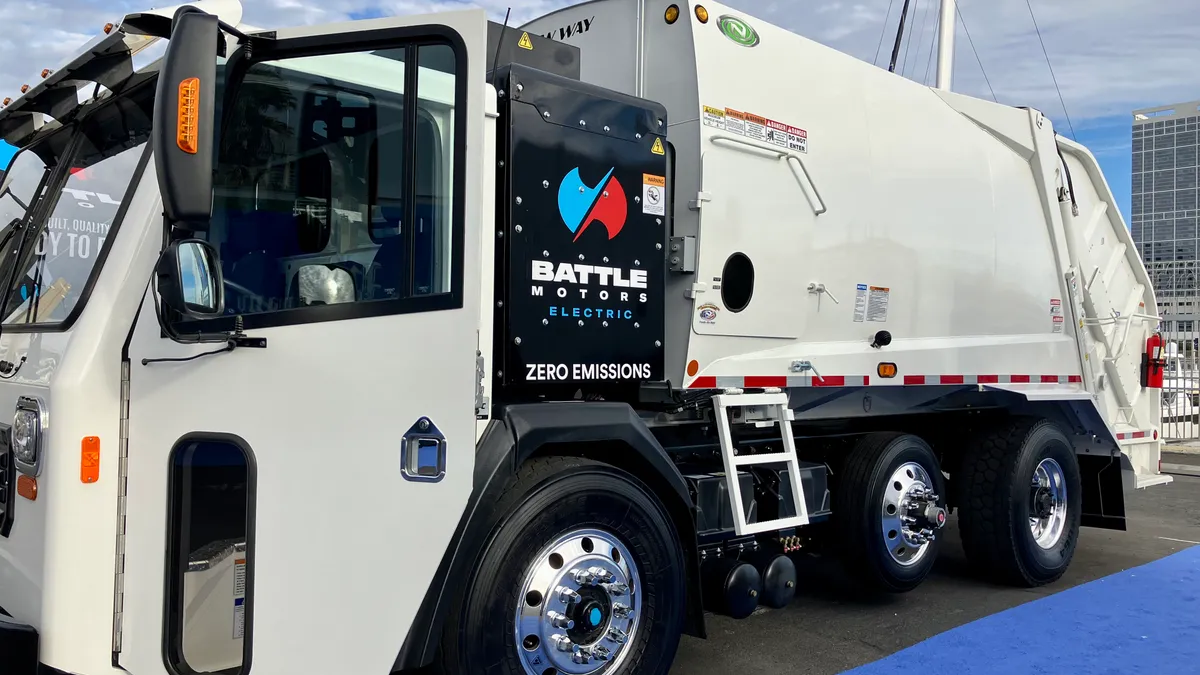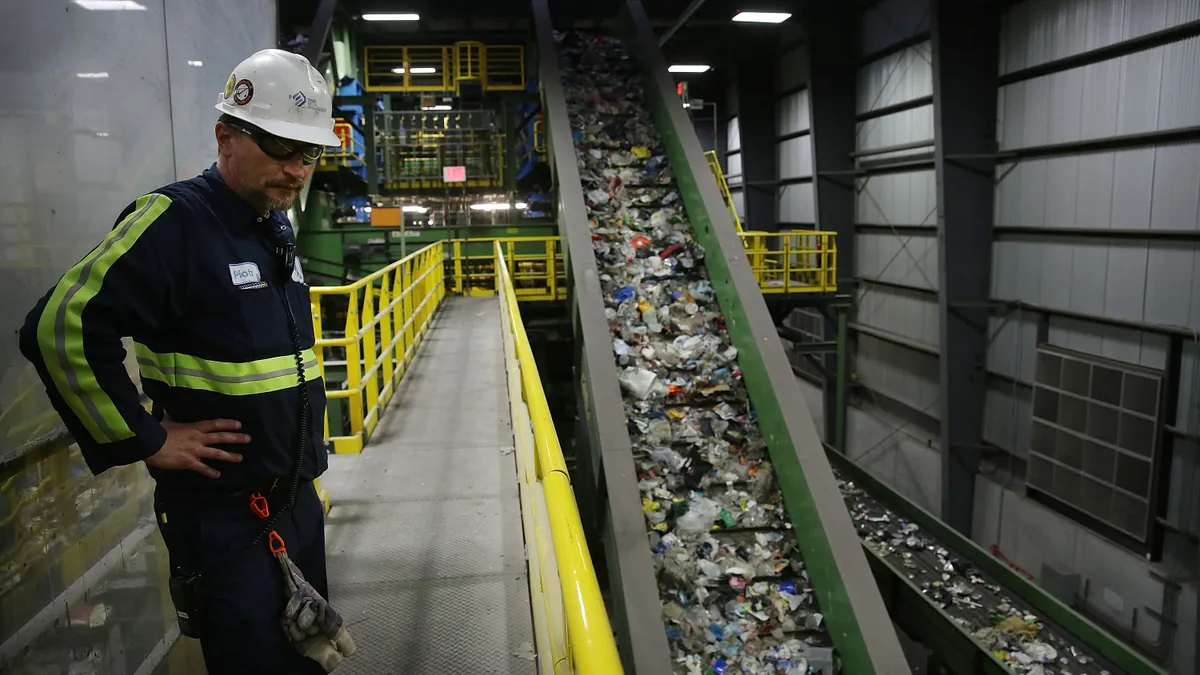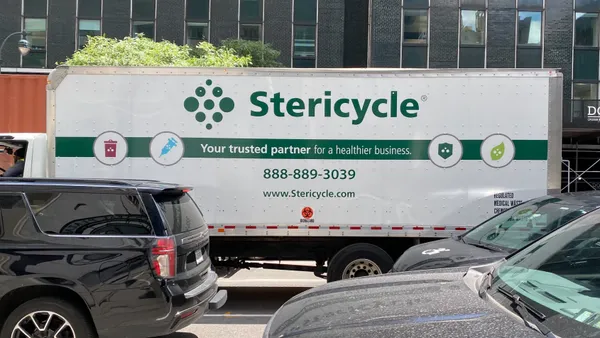The prospect of electric refuse trucks continues to draw some skepticism on performance, price and infrastructure hurdles — and interested crowds of industry listeners, including at this week’s WASTECON.
The CEO of Battle Motors, a leading sponsor of the Solid Waste Association of North America’s conference in San Diego this week, sat down with SWANA CEO and Executive Director David Biderman for a keynote discussing the impact and future of electric vehicles for the solid waste industry. SWANA shared a new report on alternative fuel vehicles in September advising that fleets continue using diesel and compressed natural gas to power trucks and to await performance and cost data from electric truck pilots.
Michael Patterson, the founder of companies including battery specialist Romeo Power (bought by Nikola earlier this year), is a newcomer to the solid waste industry, Biderman highlighted. It’s been less than two years since Patterson and colleagues entered the industry through a deal to acquire longstanding collection truck maker Crane Carrier Co. While Battle is seeking to make a big name for itself in electric, it also produces diesel trucks; most of the trucks the company produces next year won’t be electric.
Asked about impressions of the solid waste industry, Patterson highlighted the enjoyable opportunity to do deals with some family-run businesses and growing competition in the trucks space.
Patterson noted “three or four major players in this race” working hard to maintain market share, plus up-and-coming private companies. “I mean, everyone's friendly and everything, but this is a cutthroat business. There's a lot of people bidding and positioning, because everything is somewhat up for grabs when a contract term is over.”
“So I enjoy the competition, I enjoy the people, it just comes with an extra responsibility because if you don't pick up the trash the mayor's gonna get a lot of phone calls,” Patterson said.
These are some of the other topics Patterson addressed in the on-stage conversation with Biderman on Tuesday:
Costs
Patterson shared that the city of Newark, New Jersey, recently purchased eight electric trucks from Battle amid the high price of diesel. Proponents of electric like Battle Motors routinely cite total cost of ownership analysis that places electric ahead of alternatives, despite their significantly higher upfront costs. Still, “I will not claim that it works for everybody,” Patterson said. “It really depends on what the power providers charge.”
Inflation is also complicating spending decisions. “Companies aren't having as much money to spend,” Patterson said. “So unless you have a big grant or a good rebate, it's a hard decision.”
Risks
Asked about the toll of extracting resources needed for batteries, in comparison to the impact of other types of trucks and fuels: “they’re all messy,” Patterson said. As for end of life, Patterson said batteries used in Battle trucks can be recycled through a partnership with Heritage Environmental Services, or donated to an “energy poverty country” to be used for electricity.
Regarding the potential for blackouts — particularly in a state like California — Patterson said that the impact of blackouts typically doesn’t last longer than a couple days, and in a situation where there are no backups, there’s the possibility of renting diesel or CNG-powered trucks, albeit an expensive solution.
Battle has yet to test its electric trucks in very cold environments, but recently tested in Scottsdale, Arizona, in 115-degree heat and said performance was good.
Infrastructure
Whereas hydrogen-powered trucks are getting some attention in the waste industry, Patterson downplayed their role in the market, referring to it as “a complete waste of time.”
“No one wants to set up another infrastructure,” Patterson said, noting that many fleets already set up CNG infrastructure and are now looking ahead to electric.
Patterson also suggested that challenges around setting up charging infrastructure can be overblown, and that smaller municipalities can sometimes have an advantage if there’s less red tape to overcome. “It’s not all that difficult ... it's a very competitive market. There are infrastructure companies everywhere.”
Production
The company expanded an Ohio manufacturing site this year. Asked about the experience with supply chains: “You do have to work harder for parts,” said Patterson. “I think screaming ‘supply chain issues,’ and I’m sorry if this offends anybody, it’s a cop-out.”
The company has also taken charge of some parts. “We print parts, we cut parts, we punch parts,” Patterson said.
Adoption
In 2030, some 15% to 20% of new trucks could be electric, Patterson projected. Asked what the new truck market would look like at that point, Patterson noted trends in adoption of electric passenger vehicles and the fact that “trucking and commercial vehicles usually lag a little bit.” As for how far the market is from a total electric truck takeover: “at least 2050,” Patterson said.
While coastal states like New York and California with “very strong ambitions to go 100% EV” might be driving demand, Patterson said, they’re also plagued by some red tape around securing enough power. That’s “another reason why the adoption will not be as rapid, but it’s still coming.”














